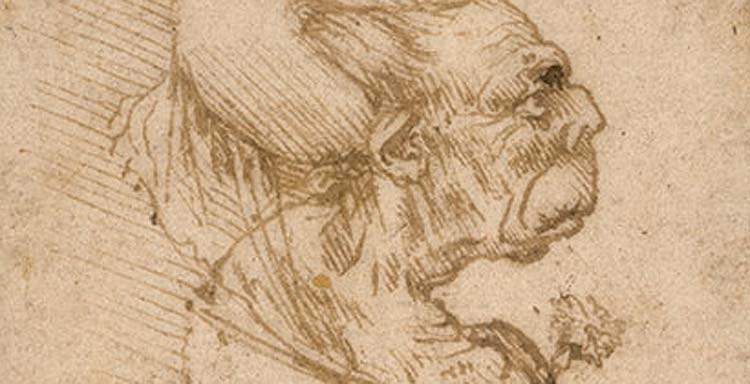Major acquisition for the National Gallery of Art in Washington , which comes into possession of a drawing by Leonardo da Vinci (Vinci, 1452 - Amboise, 1519). The work was donated by patron Dian Woodner, daughter of collector Ian. Dian Woodner over the years has donated many works to the National Gallery of Art, and now she has decided to donate to the museum a Grotesque Head of an Old Woman, dated 1489-1490, belonging to a nucleus of about thirty similar studies, identical in small format as well as in style and technique. The drawing thus joins, in the same museum, the Portrait of Ginevra de’ Benci (c. 1474-1478), the only painting by Leonardo preserved in the Americas.
These drawings rank among Leonardo’s studies of human physiognomy. Leonardo, who possessed the major ancient treatises on physiognomy and wrote about it in his notebooks, was the first artist to take that system beyond ideal types. He used it to explore the most minute physical variations and to go beyond superficial appearances to evoke personality and convey character. Like the other imaginary heads, this drawing seems to have been an exercise in itself. It helped prepare and inform the unprecedented range and subtlety of human expression in Leonardo’s paintings. His Milanese followers would later take these studies literally. This old woman appears in several contemporary copies (the National Gallery has one by Francesco Melzi, one of Leonardo’s closest followers). The influence of these drawings never waned in European art, inspiring all subsequent physiognomic studies and laying the foundations of the art of caricature.
Imaginary, but highly connoted, this woman is a relevant example of this type of drawing. It depicts the head and torso of an elderly woman with an elaborate hairstyle and wearing a bizarre headdress. Her physical peculiarities are pronounced: Leonardo, who in drawing his old woman wanted to experiment with the effects that the ravages of time make on the human body, uses a few pen strokes to suggest the wrinkled skin, the low, receding forehead, as well as the small aquiline nose, while the lower lip and chin are almost nonexistent. The lines describing the small, almost imperceptible folds of the upper lip indicate the lack of teeth. The curved but swaying lines describing the woman’s shapeless breasts, complete with a carnation inserted into the dress’s tight bodice, are echoed by the curvature of the back, resembling a small hump.

This drawing also reflects Leonardo’s interest in jokes and riddles, consistent with the taste for visual and verbal play at the Sforza court in Milan, where Leonardo worked for seventeen years. The frequency with which he drew grotesque heads is inspired by his continuous search for the monstrous, the astonishing, and the unusual, along with his quest for the beautiful and the sublime. These two contrasting aspects coexisted in Leonardo’s mind and work and constitute two of the great areas around which his studies revolved. The lowered chin and exaggerated frown of this woman might be the object of vulgar humor, but the dignity of her pose, held firmly in the profile of official portraiture, the moving accent of the carnation at her breast, and what to the eyes seems some form of self-control elevate her to a complete being of distinct form and inseparable being.
This group of drawings descends directly from Leonardo’s workshop with an unbroken and very illustrious provenance. The group was in the possession of the Dukes of Chatsworth in 1723. This drawing is one of four sold by Christie’s in London in 1984. One was purchased by the Getty, two by a private collector in New York, and this one by Ian Woodner, who assembled an extraordinary collection of more than 1,000 ancient and modern drawings, making him one of the most important collectors of the 20th century. More than 150 works from his collection now reside at the National Gallery. While Woodner donated some works himself in the 1980s, most were given by his daughters, Dian and Andrea, who both also made other donations and pledged works from their personal collections.
The drawing has been in storage at the National Gallery since it was exhibited in 1999 and was promised by Dian in 2017. It becomes the National Gallery’s second Leonardo drawing, joining a study sheet acquired with the Armand Hammer collection in 1991. There are only nine other Leonardo drawings in U.S. public collections: in addition to the one in the Chatsworth sale, there are another at the J. Paul Getty Museum, one at the Morgan Library and Museum, and six at the Metropolitan Museum of Art.
The Grotesque Head of Old is an old acquaintance of the American public, however, since it has been shown in several exhibitions held at the National Gallery, including The Touch of the Artist: Master Drawings from the Woodner Collections (1995-1996); Art for the Nation: Collecting for a New Century (2000-2001); Master Drawings from the Woodner Collections (2006); Arcimboldo, 1526-1593: Nature and Fantasy (2010-2011); and The Woodner Collections: Master Drawings from Seven Centuries (2017).
 |
| The National Gallery in Washington acquires a drawing by Leonardo da Vincni, a grotesque head |
Warning: the translation into English of the original Italian article was created using automatic tools. We undertake to review all articles, but we do not guarantee the total absence of inaccuracies in the translation due to the program. You can find the original by clicking on the ITA button. If you find any mistake,please contact us.